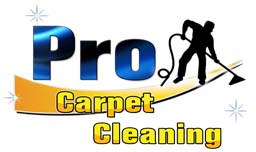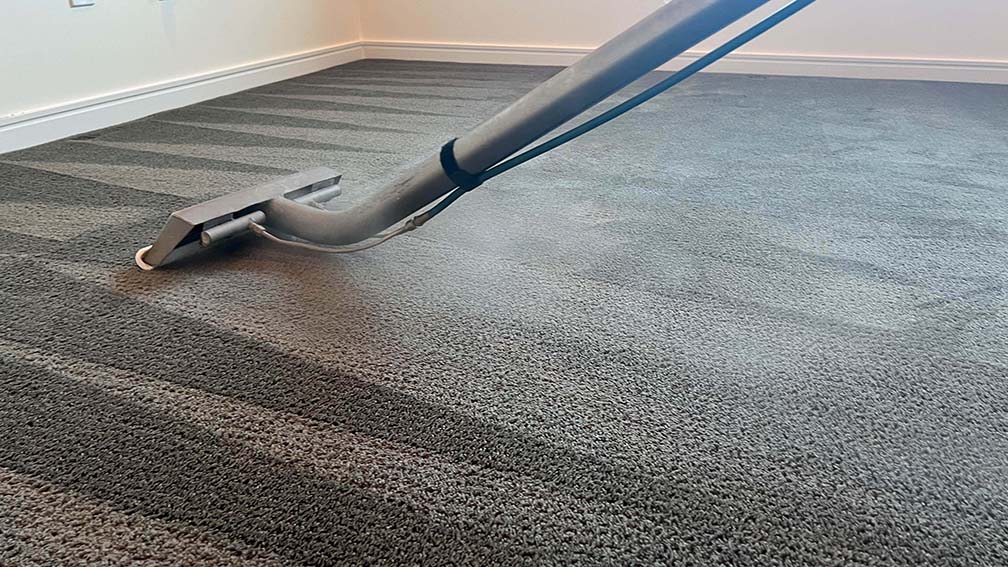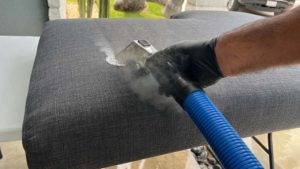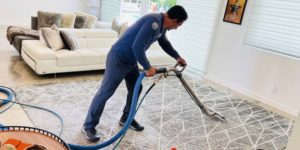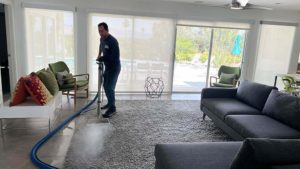Although there is an industrial cleaning process that is in fact steam cleaning, in the context of carpet cleaning, “steam cleaning” is usually a misnomer for or mischaracterization of the hot water extraction cleaning method. The hot water extraction cleaning method uses equipment that sprays heated water (not steam), sometimes with added cleaning chemicals, on the carpet while simultaneously vacuuming the sprayed water along with any dislodged and dissolved dirt.
Many carpet manufacturers recommend professional hot water extraction as the most effective carpet cleaning method. Actual steam could damage manmade carpet fibers or shrink natural fibers such as wool.The primary advantage of the hot water extraction cleaning method is that effective cleaning is possible using only hot water, or hot water with very diluted detergent solutions. This avoids the problems associated with detergent residues that can remain in the carpet with other cleaning methods. Detergent residues on carpet fibers can attract dirt from the soles of shoes as people walk on a carpet, causing the carpet to become dirty again soon after cleaning.
Since the use of detergents and other chemicals is minimized or avoided altogether with the hot water extraction cleaning method, this method is advantageous for persons concerned about possible chemical exposure, especially for children crawling or playing on recently cleaned carpets. This method also minimizes concerns about breathing volatile chemical compounds that might be used in other cleaning methods. The primary disadvantage of the hot water extraction cleaning method is that 100% of the water used cannot be removed. If poor water extraction is achieved, in conditions of high humidity, mold growth could occur or be exacerbated.
This is not usually a problem with high end commercial water extraction equipment. Moisture left in carpets after cleaning will evaporate more quickly with ventilation, heating, air conditioning or dehumidification. A variety of hot water extraction carpet cleaning equipment is available, with less expensive equipment marketed for purchase or rental by homeowners, and more expensive equipment used by professional carpet cleaners. The more expensive commercial equipment may employ a rotating high pressure spray and extraction disc. This allows the equipment to achieve many spray-extraction cycles independent of the forward or backward motion of the machine.Hot water extraction carpet cleaning equipment may be a portable unit that plugs into an electrical outlet or a truck mount carpet cleaner requiring long hoses going from the truck or trailer to the room requiring cleaning.
Truck mounted equipment is advantageous where electricity is unavailable (e.g. for cleaning premises where the electrical service was terminated when the premises were vacated by a departing tenant.) Truck mount carpet cleaning may be unsuited to premises distant from a driveway or road, and hoses may need to pass through windows to reach upper floors of a building. Hoses needed for truck mount and professional portable carpet cleaning may present an inconvenience or tripping hazard to users of hallways, and pets or children can escape through doors that must be left ajar for hoses.
Heated or air conditioned air will also escape from buildings when doors are left open for hoses. This could create a significant waste of energy in some climates. While truck mounted carpet cleaning equipment minimizes noise in the room being cleaned, truck mounted carpet cleaning equipment may cause noise and air pollution offensive to neighbors and may violate anti-idling bylaws in some jurisdictions. However truck-mounted cleaning is much faster than portable equipment and extra heat and power can give better results and faster drying times. A Rug Doctor rental carpet cleaning machine.
For more details on this topic, see Hot water extraction. In high-pressure hot water extraction (“steam cleaning”), after preconditioning, with alkaline agents such as ammonia solution for synthetic carpets or acidic solution (such as vinegar solution) for woolen carpets, and agitation with a grooming brush or an automatic scrubbing machine, a pressurized manual or automatic cleaning tool (such as a wand) passes over the surface several times to thoroughly rinse out all preconditioner, residue, and particulates.
If an alkaline detergent is used on a woolen fiber, use of an acetic acid solution will restore neutral fiber pH. The acid rinse thus neutralizes the alkaline residues, and can contribute to softening cleaned fabrics. The steam-cleaning system uses detergent-based solutions. The surface is saturated, typically taking 12–24 hours to dry. Some carpet-cleaning solutions are carbonated to dissolve organic material more effectively. Beyond these treatments, antistaining and antisoiling products can be applied by the carpet owner, and have for this reason become recognized in the carpet-cleaning industry as some of its biggest profit centers.
Truck mount steam carpet cleaner-extraction is by far the most important step in this process. Since the hot-water extraction method uses much more water than other methods like bonnet or shampoo cleaning, proper extraction and air flow are critical to avoid drying issues. Drying time may also be decreased by extra use of fans, air conditioning, and/or outdoor ventilation. Older surfaces, such as double jute-backed carpets and loose rugs with natural foundation yarns, could shrink after a wet treatment, leading to suppositions that wet-cleaning could also remove wrinkles. However, this notion is antiquated and this method could also occasionally tear seams or uproot strips. Newer carpets, such as with synthetic backing and foundation yarns, do not shrink, and they smooth easily; in such carpets, wrinkles indicate an underlying problem, such as adhesive, that may need a certified carpet inspector to determine.
Wet-cleaning systems naturally require drying time, which has led to customer fears and concerns about very slow drying, the risk of discoloration returning during drying, and odors, bacteria, fungi, molds, and mildews. Balancing the need for rapid drying (attributable to lower flow rate through the cleaning jets of a spray system) and the need to remove the most soil (attributable to higher flow rate) is a key technique that must be mastered by carpet-cleaning technicians. Pretreatments similar to those in dry-cleaning and “very low moisture” systems are employed, but require a longer dwell time of 15 to 20 minutes, because of lower amounts of carpet agitation. Ideal pretreatments should rinse easily and leave dry, powdery, or crystalline residue that can be flushed without contributing to re-soiling.
